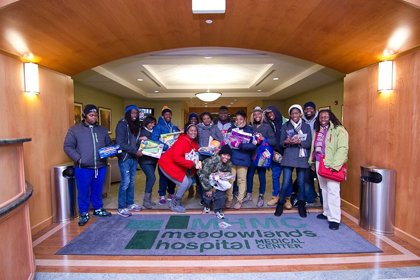Ranisha Coppage was on a road to nowhere. School was a drag for the 17-year-old junior, who had a habit of cutting classes missing as much as 100 days in a year.
Ranisha often butted heads with her mother and her interests mostly included going against the grain, hanging out and not doing any school work.
I was in the cafeteria one day and I heard someone talk about the Quantum program and they also mentioned getting paid, so it interested me,’94 Ranisha said. Once in the program, everything changed. The program has helped my life a lot. I did a total change, Ranisha said.
Her grades gradually climbed and the relationship with her mother greatly improved, said Ranisha, whose goals now include becoming a lawyer.
Funded by the Eisenhower Foundation in Washington, D.C., the Quantum
Opportunities Program is an intensive, year-round, multi-component best practice model that invests in cohorts of disadvantaged teens through all four years of high school.
The program’s goals include grade improvement, high school graduation and advancement to postsecondary education or training. The model facilitates the many functional skills that are needed by young people for success in the home, workplace and community. It also seeks to reduce delinquency, crime, drugs and truancy.
We definitely want to instill a sense of responsibility and accountability into students and we want to make their matriculation through high school a successful one,’94 said Tsanonda Edwards, the executive director of the program in Baltimore.
We are making sure that students have the correct mentoring and that we are pushing them. We try to do things progressively and we are now gearing up for the summer portion,Edwards said. This is not only an after school program, but a summer program. We are always available to the students.
The program currently serves 25 students as a part of two schools in Baltimore, the Augusta Fells Savage Institute of Visual Arts and the Baltimore Talent Development High School.
Quantum Opportunity emphasizes long-term commitment and case management follow-up over several years to lower dropout rates and track success. It combines mentoring, tutoring, recreational programs, and financial incentives to attract and retain at-risk youth.
Quantum also helps students develop communication skills, healthy relationships, problem-solving and decision making skills, critical thinking, assertiveness, peer resistance and selection, stress reduction, leadership and appreciation for diversity.
There is still work to be done, Edwards said. When you’re dealing with the high school population you have your share of obstacles.
When the program started almost four years ago, the goal was to include 30 students, Edwards said. The program started with just three students and quickly grew to 15, and now there are 25 students taking advantage of the opportunity.
Our young people are definitely making strides. Continuous progress, Edwards said. ’93Being there and being consistent, and making sure we’re there to listen has been important. We make sure to tell the students to call us or [to] text us anytime. We may not answer every single time, but we make sure and get back to them and they know they can count on us!
